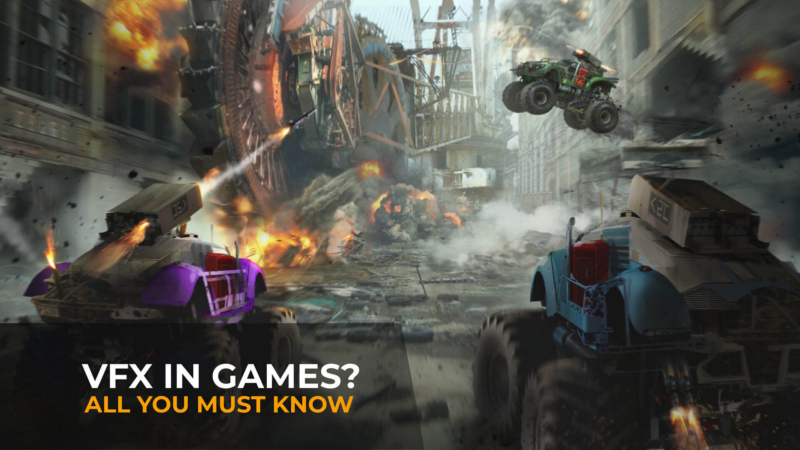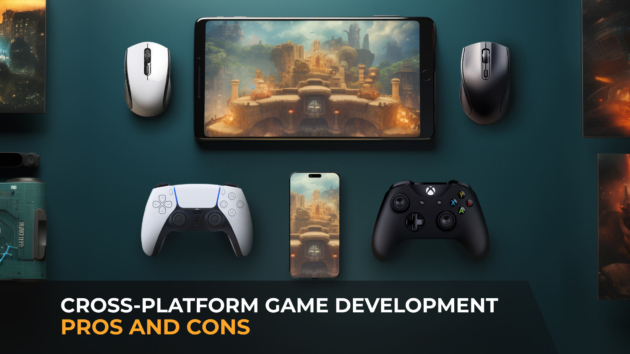Visual effects, or VFX for short, are a vital part of multimedia entertainment.
When people talk about VFX in games, they typically mean real-time visual effects, which serve as a crucial building block for creating captivating interactive experiences. At a fundamental level, we consider visual effects to be ‘good’ when elements like fires, crashes, explosions, lightning, and more enhance the visual appeal without compromising gameplay fluidity, all while appearing visually striking and realistic.
Real-Time Rendering vs. Pre-rendered Visual Effects
Gaming VFX often have real-time rendering requirements, making them distinct from meticulously crafted pre-rendered effects commonly seen in movies.
In cinematic visual effects, elements are artfully layered together beforehand to choreograph dynamic visual sequences that captivate audiences during screenings. However, in games, regardless of whether they run at 60, 122, or 144 frames per second (FPS), VFX artists must ensure that the effects seamlessly integrate with the dynamic flow of the title, support interactivity, enhance gameplay mechanics, and enable flexibility for adaptive experiences.
Why VFX in Games Are Hard
When it comes to VFX, there are many ways to do the same thing. Each effect presents its own unique challenge, and VFX artists have a wide variety of techniques and workflows at their disposal to address it.
Technical and artistic balance in game development process
To create visual effects properly, game developers and VFX artists must consistently strive to balance their artistic vision with the technical constraints of both hardware and the game development engine being used.
This can be challenging because, in order for a title to stand out, it must possess a degree of uniqueness that requires clear communication of the VFX artist’s intent in terms of theme, emotion, and gameplay narrative. However, to reach a broader audience and provide an engaging gaming experience for all players, it should be as computationally efficient as possible. Finding the sweet spot is critical here: the technical aspects, such as graphics and sound, should support and complement the artistic vision. Only in this way can truly immersive game worlds and emotionally resonant experiences be created while avoiding any performance issues.
Interactivity, visual quality, and dynamic game environment
As an extension of the previous point, visual effects must not only look good but also seamlessly adapt to the game’s dynamic and changing environment without compromising gameplay fluidity.
This means that VFX should accurately reflect different lighting scenarios, weather conditions, terrain changes, and more, all while maintaining the title’s overall visual quality. Even a single visual imperfection can significantly worsen the overall impression of the game.
The same principle applies to player actions, which, within game worlds, must also influence how VFX are displayed and their resulting outcomes. Therefore, game developers and VFX artists must account for a multitude of interactions and their corresponding scenarios, which can considerably complicate VFX implementation.
VFX testing in video game development
To ensure interactive visual effects seamlessly integrate into the title’s environment, both in appearance and functionality, an extensive and iterative testing strategy is required.
Therefore, Stepico’s experienced game developers, VFX artists, and testers work in unison on each project. Having years of experience, we have established a set of practices that enable our specialists to complement each other’s efforts. Our experts always ensure that the effects meet the client’s quality standards, perform well across various platforms, and enhance gameplay while sharpening the game’s aesthetics.
Particle effects, character, environmental, post-processing, and more VFX types
Another reason visual effects are challenging is that they are typically quite diverse, even in non-complex games. Whether it involves explosions, projectiles, character animations, certain particle effects, UI design, post-processing, or any other type of VFX, they all possess specific properties and constraints related to physics simulation, dynamics, and artistic direction.
Experienced VFX artists must, therefore, have the ability to identify the most suitable techniques and tools for each specific project and adjust their preferred toolset to meet the specific requirements of the title. This leads us to the next section.
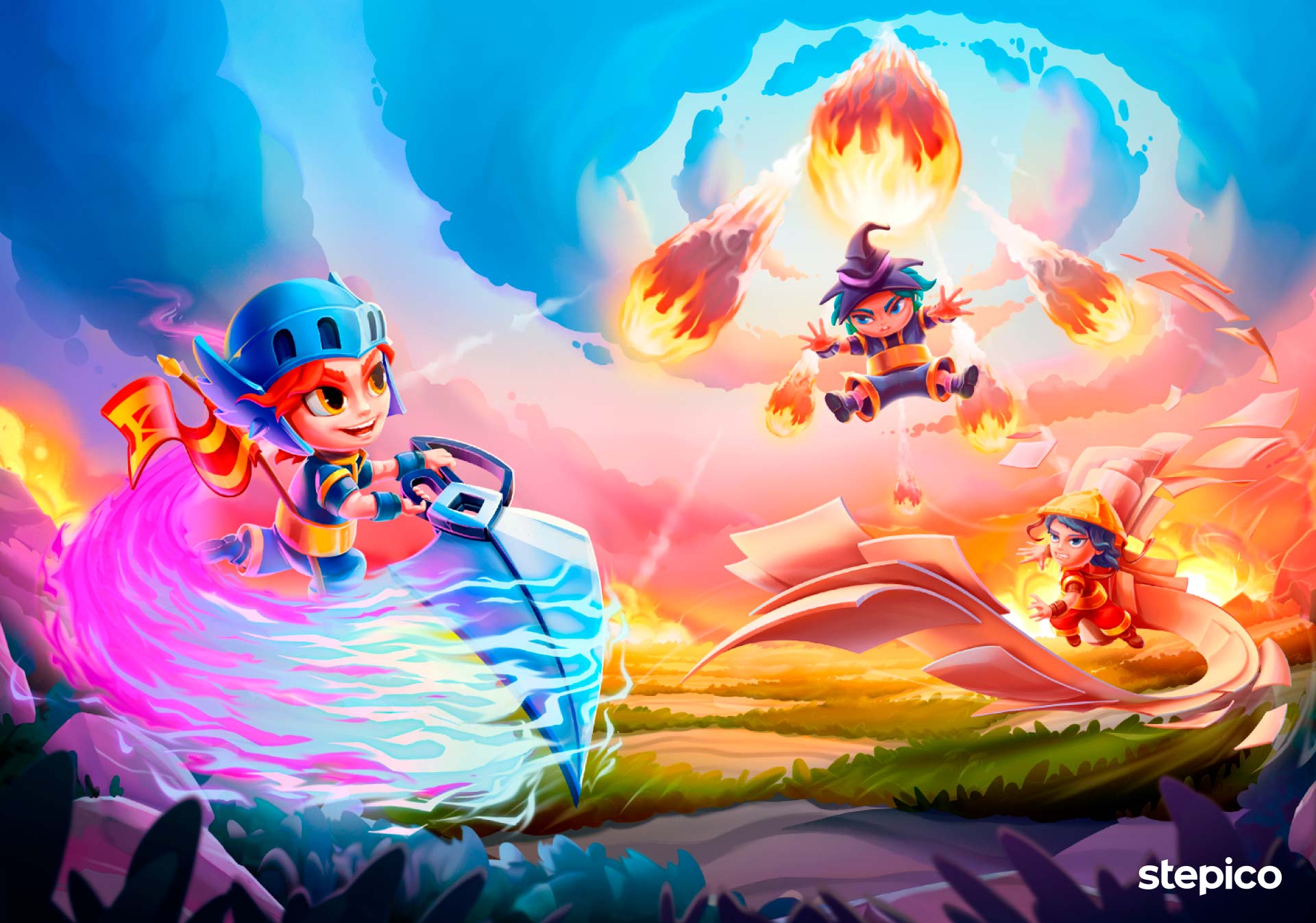
Plethora of tools used in VFX
Game development and VFX creation can encompass 3D modeling, UV mapping, Physically Based Rendering (PBR) materials, texture creation, noise and normal mapping, procedural noise generation, 2D and 3D animation, semiotics, color theory, shape timing theory, etc.
However, within this extensive toolkit, the central element tends to be the particle system. In fact, particle systems are powerful and versatile enough that entire games of decent quality can be created by using them alone.
In a nutshell, particle systems’ function is to ‘throw out’ various entities and seamlessly integrate them into the game’s environment. These entities could include textures, meshes, ribbons, decals, lines, shaders, points, and so on.
How Are Particle Systems Used to Create Visual Effects?
At the core of each particle system is an emitter. In simple terms, an emitter is an invisible point in space that can ‘launch’ elements into an environment.
They come with a variety of parameters and options. VFX artists can fine-tune and manipulate emitters’ settings to create different object movements. These movements can range from a droplet falling from the sky, splashing against the ground, and breaking into a thousand tiny pieces to something as simple as a static image of an object, like an animal, always positioned in one place within the game and barely moving.
Fireball as an Example of an Effective VFX in Games
One of the most commonly utilized visual effects in modern games is projectiles, such as fireballs. Let’s use them as an example of how skilled VFX artists build a sophisticated effect.
Fireballs consist of three parts: the primary, secondary, and tertiary components. A viewer’s eye follows these elements in order, starting with the primary component at the top. Therefore, it’s crucial to make it visually captivating. That’s why the heads of fireballs are designed to stand out – they typically have a vibrant glowing texture on a camera-facing card. Once we’ve created something ‘special,’ the glow can be enclosed within a mesh, resembling half of a sphere, and an animated fire texture can scroll across this mesh, creating the impression of dynamic, brightly burning fire.
Next, it’s time to enhance the fireball with finer details using a secondary component. Typically, this involves adding a tail – a ribbon extending from the head of the mesh, usually composed of a single texture scrolling from left to right.
Finally, there’s the third, tertiary read, which consists of sparks bursting from the fireball. A skilled VFX expert will shape them to complement the projectile theme, but also ensure that they aren’t overly pronounced to avoid distracting viewers from the two main elements of the effect and hampering its clarity.
Creating VFX, Avoiding Clutter
When creating VFX, it’s essential to exercise some restraint. What we mean is, if all the effects are flashy and there’s lots of action packed into each of them, none will stand out. The environment will simply feel cluttered.
The purpose of these effects is to communicate gameplay, and for this communication to happen, clear contrasts must be implemented between essential and non-essential VFX.
How Stepico’s Game Development Experts Establish Contrast, Visual Hierarchies, and Realistic Environments
The tools our experts typically use for these purposes are shape, color, and timing.
How VFX artists use shapes
All visual effects consist of shapes, such as lines, squares, stars, circles, spheres, and so on. They could be geometrically correct or, at times, VFX artists will purposely make them odd and irregular.
In each game Stepico creates, there’s a consistent shape language. We always take the time to establish a certain standardization of how shapes are used throughout the title. This is necessary for several reasons. Firstly, each complex game will probably have hundreds of effects, each with its own meaning. And a consistent shape language helps us clearly communicate to the user what the effect does, thereby conveying the game’s narrative.
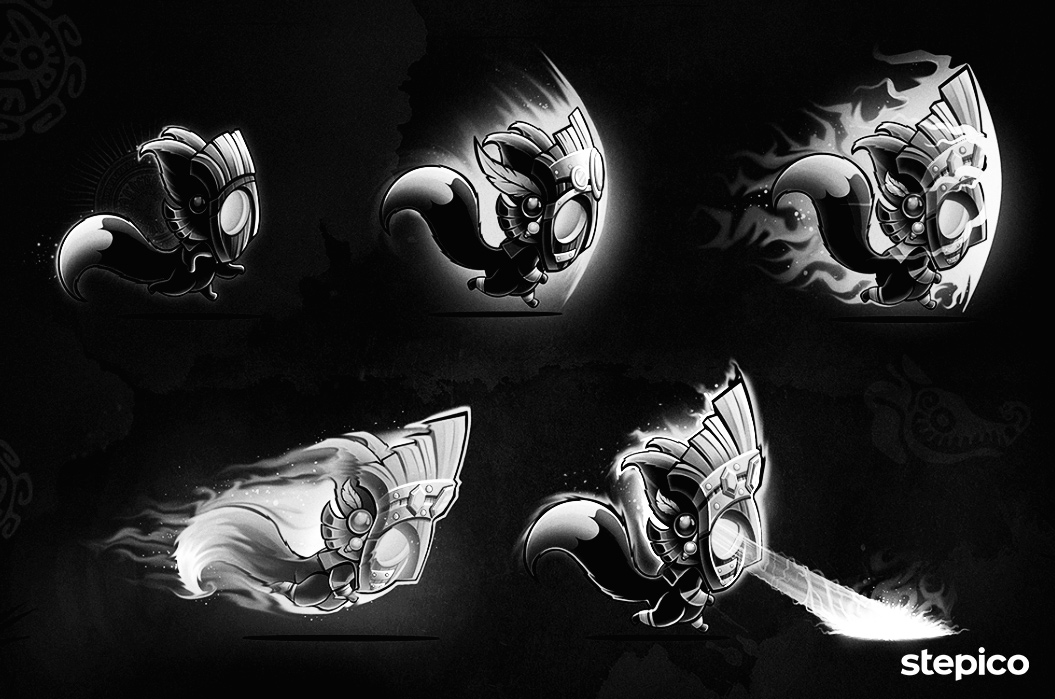
A plus sign, for instance, can signify the restoration of a character’s health. A sphere that encapsulates an object may indicate that a shield has been activated to protect the character or another entity from danger.
Secondly, distinct shapes language is even more important when the colors of different visual effects are similar – it allows the player to easily differentiate between them.
How VFX artists use color
Color is just as vital for VFX as shapes. Properly chosen colors serve as powerful communication devices, conveying essential information about the effect. For example, in combination with shapes, colors can be used to indicate the severity of damage a character is dealing or receiving. You’ve probably encountered this in first-person shooters when sudden blood spatters appear, and the screen turns bright red after severe hits. The shapes show what happened, and the color communicates the level of intensity.
Additionally, colors can be utilized by VFX artists to create atmosphere and mood. If the game’s environment is mainly black or gray, the player is likely to feel a sense of uneasiness and anticipate danger. On the other hand, when the screen is dominated by various shades of yellow, blue, and green, they will perceive the colors as signs of safety.
Visual effects in games are not static. They have a lifespan, and colors can reflect that. The beginning, or the phase of the effect that has the most energy, should be highlighted by the brightest and most intense colors. For example, when a grenade explodes, the user sees a bright flash that gradually subsides, transitioning into a warmer, less vivid color. Finally, at the last stage, smoke may appear, usually dark gray or black, before the effect dissipates completely.
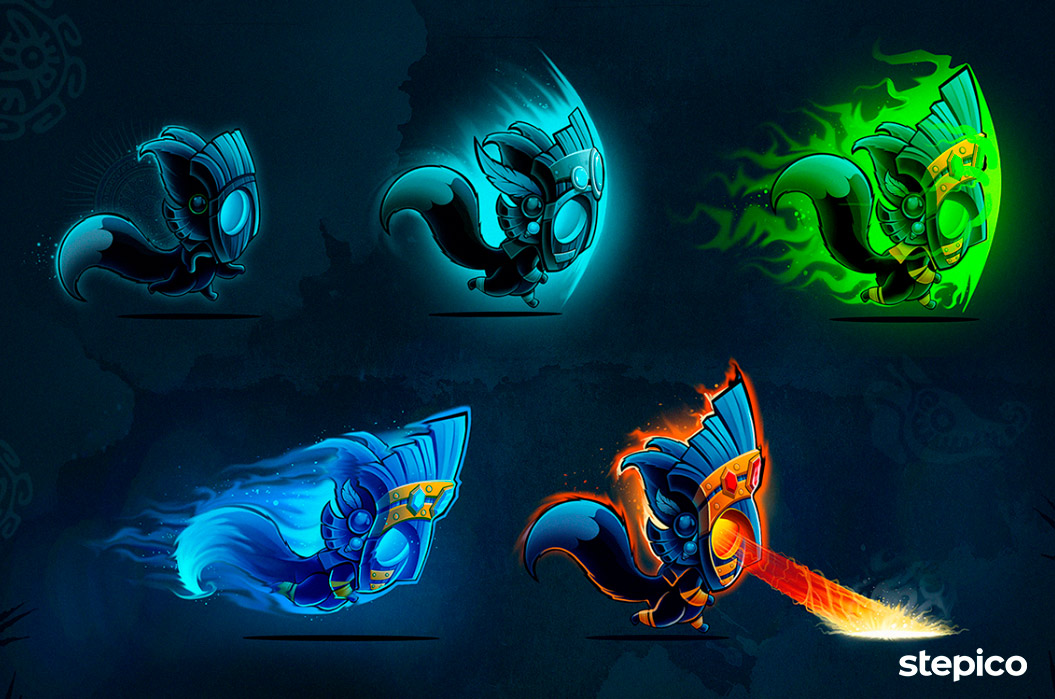
This transition from bright to medium intensity to dark clearly demonstrates how the stages of the effect’s lifecycle change one another.
Some games, like our upcoming first-person shooter Discovery, feature hundreds of visual effects. And in such cases, a well-thought-out color strategy is particularly important for game development.
At Stepico, our first step is to define the main and supporting colors. We designate essential parts of VFX with the main colors—brightest and most saturated—while secondary parts are distinguished by supporting colors, which are more subdued. Sometimes, we make the less critical colors somewhat translucent to blend them into the environment. We also carefully consider how we utilize hues, which, too, are essential for gameplay. Accidentally blending two contrasting hues together can severely impact the game’s readability.
Color saturation is also a great tool for defining the effect’s meaning. High saturation is typically utilized when we want to draw the player’s attention to something, whereas lower saturation conveys a sense of calmness, signifies the absence of urgency, and thus indicates that this part of the effect is less important. Generally, we advise against having too many saturated colors in a game as it can lead to clashes. Experienced VFX professionals will always leverage their profound knowledge of color theory to create harmonious schemes, construct highly aesthetic compositions, guide the user’s attention, ensure captivating gameplay, and reinforce a title’s unique identity.
How VFX artists use timing
The third important aspect of VFX that we’ll cover in this article is the speed and timing of various effect components. Let’s once again consider an explosion effect as an example.
An explosion is essentially just a circle that rapidly expands at first and then comes to a halt after reaching its maximum size. Although this may seem simple, the effect’s progression cannot be executed in a linear way, as that would make it look both unrealistic and unexciting.
There are distinct phases to this VFX. The initial stage, during which the circle enlarges, must be the most rapid. Then, as the expansion nears its end, the tempo of enlargement needs to slow down. The buildup to the explosion can also be timed in an interesting and inventive manner. These variations in timing can evoke awe, fear, surprise, or other emotions in players, thereby strengthening their emotional connection to the game.
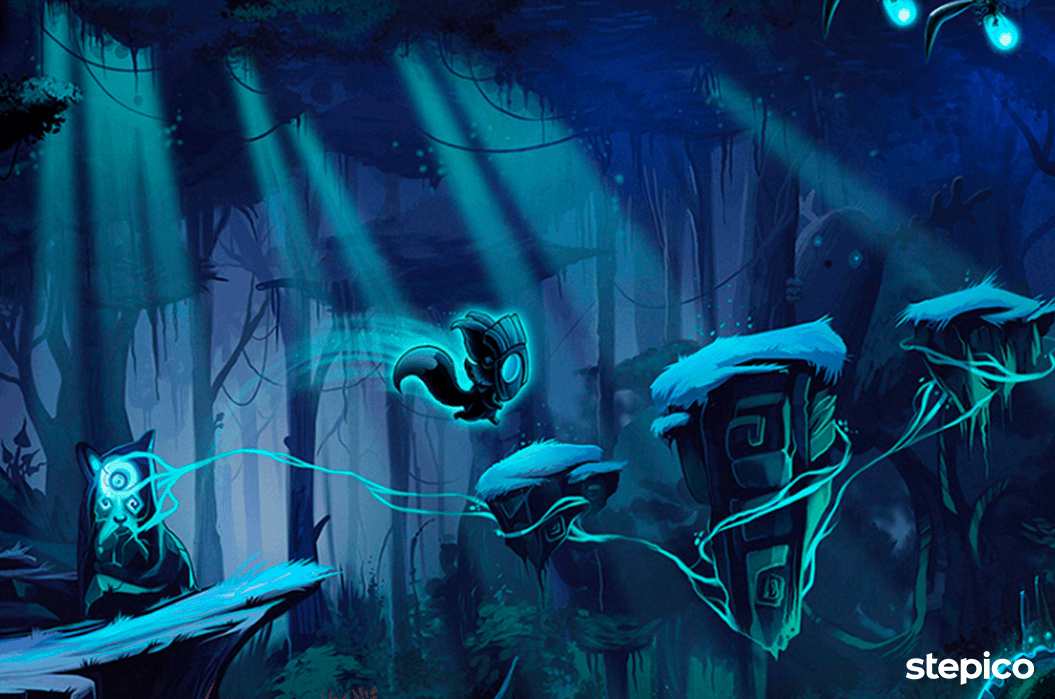
The timing of properly executed effects must align perfectly with the rhythm and pacing of the title’s narrative. However, it is quite easy to mess up, and, if done incorrectly, it can completely disrupt the fluidity and seamlessness of the storytelling. Just as with shapes and colors, timing can be an excellent auxiliary tool when constructing an atmosphere, whether it’s one of suspense, tension, or another mood.
Furthermore, it is crucial for creating realism within the game. Each digital element must interact realistically with the game’s environment, especially in terms of lighting and shadows. In action sequences, the timing of VFX is what either makes or breaks the feeling of authenticity. In general, if any of the VFX are timed incorrectly, the illusion of reality and the immersion of users will be completely shattered.
Summing Up
VFX can seem vast, daunting, and downright intimidating to inexperienced artists. And yet, it’s impossible to create realistic environments and immersive gaming experiences without powerful and well-timed effects. That’s why Stepico’s experts, who have honed their skills over years of practice, always pay special attention to meticulously plan, craft, and execute VFX on each project.
VFX largely shape a player’s experience. Their role is not limited to adding flair to the title’s aesthetics; they’re tools used to make the game’s world immersive and exciting so that the players can completely lose themselves in it for hours on end. The fiery explosions in an action-packed, high-octane first-person shooter, the subtle character expressions in a narrative-driven adventure game, and the projectiles signifying magic spells in a fantasy RPG – these are all elements that help a skilled VFX artist truly bring game worlds to life.
Our game developers and VFX artists are well-versed in the latest VFX techniques, tools, and methodologies. We always make sure to apply our vast knowledge to make the effects in our clients’ games enhance immersion by providing striking visuals and creating the necessary atmosphere, driving the storyline by drawing the player’s attention to game elements at certain times, and establishing top-notch visual aesthetics overall.
Want to learn more about how to use VFX to entice, engage, and captivate your audience? Want to build a new visually striking game? Reach out to us right now for a quick consultation!
